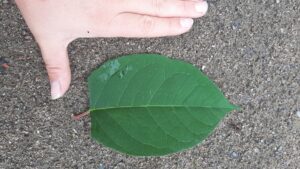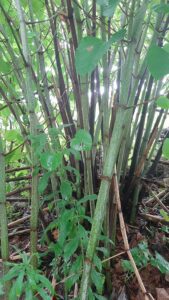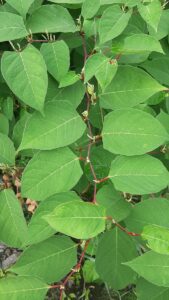The Municipality of Mille-Isles needs your help to combat invasive alien species. Help us control the spread of these species by reporting their presence on the territory at 450-438-2958, ext. 2602 or by e-mail at gtherrien@mille-isles.ca.
Report the presence of any invasive exotic species on the Sentinelle tool of the Ministère de l’Environnement at the following address: https://www.pub.enviroweb.gouv.qc.ca/scc/observation/carteobservations.
Work on invasive exotic species in wetlands or waterways may require authorization from the Ministry (MELCC) and/or the municipality. Contact us and/or the Ministry’s regional office before intervening in these environments.
Find out more about Japanese Knotweed
How to identify it?
What to do?
Some methods exist to control Japanese knotweed colonies. The choice of method will depend on several factors related to the characteristics of the colony and the environment in which it grows.
However, the most widely used method is the mechanical process which consists of:
- Cut the stems flush with the ground with a pruning shears or a pruner;
- Place cuttings in leak-proof bags to be left in the landfill site. Japanese knotweed should never be composted or put at the edge of the forest, as it will come back to life;
- Install a geomembrane on the invaded area. It is important to put heavy stones or tree trunks all around the membrane to prevent the plant from coming out from the sides. This step is crucial, the goal is to suffocate the plant and its root system. It will be important to keep an eye on the evolution of the eradication;
- It is very likely that a cut of the new shoots around the tarp will be necessary every month;
- Plan a plantation of native species where you have controlled it to ensure that it does not regrow.
How to reduce its proliferation?
Because its eradication is extremely difficult, here are some tips to follow:
- Avoid cultivating it;
- Avoid mowing the lawn, as mowing residues will help disperse it;
- Do not try to pull it out: its rhizomes are very deep and you risk forgetting fragments in the soil;
- Inform the people around you of the presence of Japanese knotweed.
Environmental and economic issues
By appropriating all the space and threatening the survival of other species by releasing toxins into the soil, Japanese knotweed limits biological diversity and attacks the integrity and balance of ecosystems.
It has a negative impact on the environment, including wetlands. If this plant is found on a shoreline, its erosion by water could transport segments of the plant and propagate it on all the shores of the lake.
In addition, this plant can cause significant damage to infrastructures such as the septic field or the foundation of a house. Its ferocious roots become as big as a coin and infiltrate up to seven meters (7 m) from the initial plan.
Find out more about Common Reed (Phragmites)
How to identify it?
Common reed inhibits the growth of other plant species, resulting in invaded areas with very low species diversity. It can also modify soil structure, hydrology and animal diversity in invaded areas.This plant needs good light conditions to grow. It colonizes a wide variety of soils and prefers damp or very damp places, such as the banks of streams and lakes, ditches, marshes and wet meadows.
Common reed stems are stiff and grayish-green, pale yellow or beige in color. They measure from 1.5 to 2.5 meters. Its flowers are duster-shaped with several golden or purple branches, turning grayish in autumn. They persist throughout the winter. Warning: common reed is similar to certain native species such as American reed, reed canary grass and miscanthus. Refer to the Ministry of the Environment website for more details:
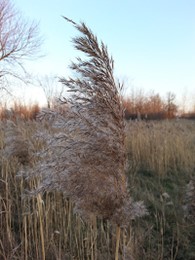
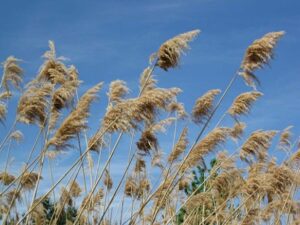
Source: MELCC
How to control Common Reed?
o Plants can be dug out of the ground.
o Stems can be cut every two to three weeks during the summer to stimulate production of new stems and reduce colony vigour.
o Covering the plant with a tarpaulin can prevent it from growing and dying. To use this technique, use a high-quality geotextile fabric or geomembrane. Mow the plants to the ground and lay down the tarpaulins so as to cover the entire colony. Use weights to hold the covers in place and inspect them regularly.
o Keep the covers in place for at least 2 years and then plant fast-growing shrubs.
How to reduce its proliferation?
Common reed is very difficult to eradicate. Ideally, control should begin as soon as colonies appear and continue over several years.
o Avoid sowing, planting, propagating or transporting it.
o Learn to recognize it so as not to confuse it with native reed.
o Report its presence using the Sentinel tool.
o Seed or plant competitive plant species that will quickly cover the ground and provide shade.
o Avoid dispersing it when moving soiled machinery or transporting soil. Avoid using this soil.
o Dispose of common reed residues in the garbage. Don’t leave it in nature, and don’t put it in the compost.


